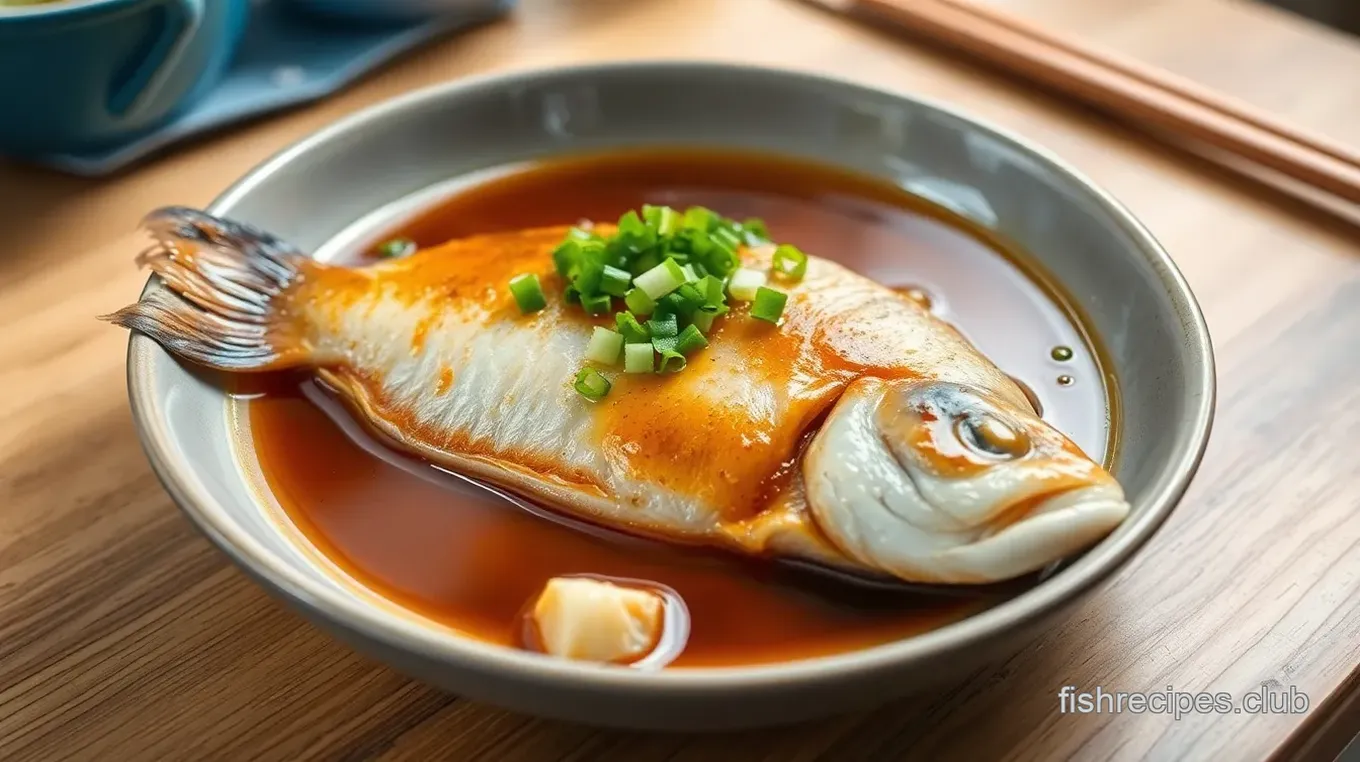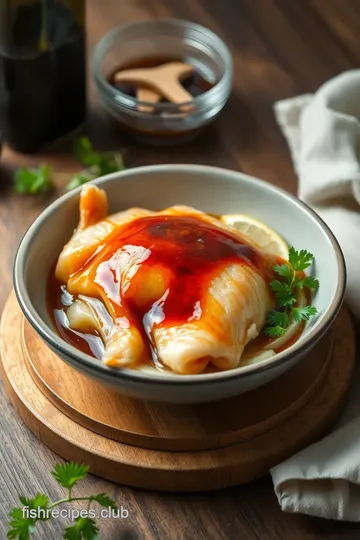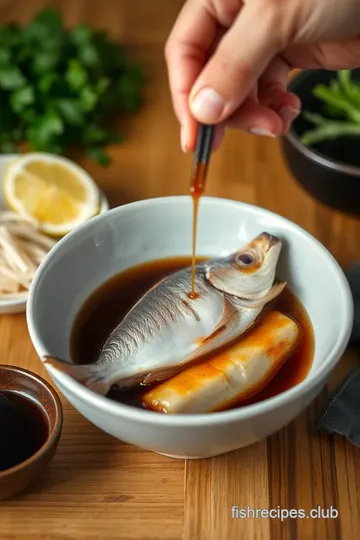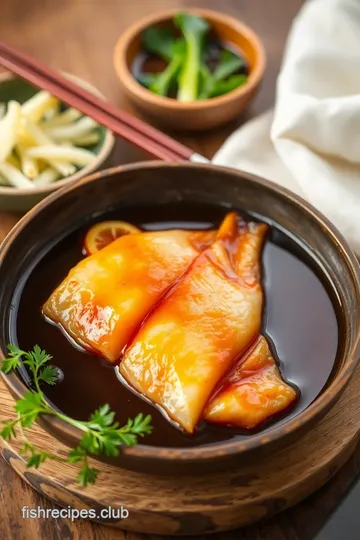Steam Fish with Ginger & Soy Sauce
Looking for a quick dinner? My go-to Steam Fish with Ginger & Soy Sauce in 25 Min is delicate, flavorful, and a breeze to whip up. Trust me, you'll love it!

- Discovering the Joy of Steamed Fish with Ginger & Soy Sauce
- A Taste of Tradition
- Boost Your Plate with Benefits
- The Magic of Simplicity
- Step into Cooking Bliss
- Essential Ingredients Guide
- Mastering the Art of Steaming Fish: A Quick Guide
- look into into the Dish: Steamed Fish with Ginger & Soy Sauce in 25 Minutes
- Frequently Asked Questions
- Recipe Card
Discovering the Joy of Steamed Fish with Ginger & Soy Sauce
Ever had one of those nights where you just want to whip up something light and tasty without spending hours in the kitchen? i totally get it! a while back, i found myself staring into my fridge, hunting for a quick and easy recipe .
That’s when i stumbled upon steam fish with ginger & soy sauce in 25 min – a dish that not only asked for minimal fuss but also promised big flavor.
Let me take you through why this dish has become a staple in my weeknight dinner routine.
A Taste of Tradition
So, what's the story with this dish? steamed fish is a classic in asian cuisine , often enjoyed at family gatherings and celebrations.
It dates back through centuries in various cultures, displaying how food brings people together. today, this simple yet elegant dish has become as popular as that favorite block party bbq.
And let's be real, it’s a hit among health ensoiasts too, thanks to being one of those low-calorie recipes that doesn’t skimp on taste.
Quick Prep, Easy Cook
I’m all about keeping things simple, and this recipe delivers! we’re talking 15 minutes of cooking perfection , with just 10 minutes of prep .
Perfect for busy weeknights, you’ll have a delicious dinner waiting at the table before you know it. plus, it only costs a few bucks, making it a winner for me and my wallet.
Boost Your Plate with Benefits
Now, let’s talk turkey! (or, i mean fish!) if you're searching for healthy dinner ideas , you’ve hit the jackpot here.
This dish features flaky fish fillets like cod or halibut, which are not just delicious but also packed with protein.
The ginger? it’s not just there for flavor. it has awesome anti-inflammatory properties and gives your body a nice boost.
Serving this dish is like hitting a home run at a potluck. it’s light, fresh, and a showstopper! perfect for gatherings or when you want to impress someone special without breaking a sweat in the kitchen.
Honestly, i’ve served it up for friends and family, and they always come back for seconds!
The Magic of Simplicity
Now, if you’re wondering what makes this dish stand out from other seafood recipes, it’s the ginger soy sauce recipe that truly seals the deal.
The lovely balance of umami from the soy sauce, the zesty kick from the ginger, and a hint of sweetness make each bite delectable.
Trust me, this isn’t just another piece of fish on a plate; it’s a culinary experience , highlighting fresh herbs and spices while keeping things gourmet at home .
Perfect Pairing
Need to serve it with something? seriously, the options are endless! pair your steamed fish with some fluffy jasmine rice or a zesty fresh cucumber salad to really elevate your dinner game.
It’s all about creating that perfect harmony of flavors and textures.
Step into Cooking Bliss
So, whether you’re a seasoned pro or just diving into cooking, this dish is made for you. ready to try this quick seafood dinner that delivers a burst of flavor and freshness? let’s go over the ingredients you’ll need to get started on this fantastic journey of flavors.
Honestly, you'll be feeling like a kitchen rockstar in no time!
Steaming food techniques are often underrated, but they’re seriously a game changer. less oil, more flavor, and you keep all those lovely nutrients intact.
And hey, cooking doesn’t have to be a hassle – it can lead to some delicious meals and awesome memories.
Let's get to the ingredients and show your taste buds what you've got!

Essential Ingredients Guide
Alright, my friends! so you want to level up your cooking game without fussing over endless ingredients? you’ve come to the right place.
Whether you're whipping up a quick steamed fish with ginger & soy sauce in 25 min or experimenting with new asian fish dishes , knowing your essential ingredients is key.
This guide will break it down for you, from the must-have spices to the tools that’ll make cooking feel like a breeze.
Premium Core Components
First off, let's chat about the premium core components . These are your go-tos. For those flaky fish fillets you might be dreaming about, like cod or halibut, here’s what you need:
- Measurements: You’ll want 2 (6 oz) fillets (that’s about 170g if you’re measuring in metric). Always double-check them!
- Quality Indicators: Look for fish that’s shiny and moist. No dull and dry stuff here, please!
- Storage Guidelines: Keep fish in the coldest part of your fridge and use it within 1-2 days . Freshness is everything!
- Freshness Tips: Smell it. It should smell like the ocean, not like… well, something else.
Signature Seasoning Blend
Now, let’s kick it up a notch with your signature seasoning blend . This is where magic happens!
- Essential Spice Combinations: For our fish recipe, the star is soy sauce. But, you could mix it up with a splash of sesame oil or even a little honey if you're feeling sweet.
- Herb Selections: Fresh ginger is non-negotiable here. It gives that zing! Adding green onions on top takes it up a level.
- Flavor Enhancers: Don’t forget that teaspoon of sugar in your marinade. It balances the saltiness of the soy sauce perfectly!
- Regional Variations: Can't find soy sauce? Try tamari for a gluten-free option. Get creative!
Smart Substitutions
What if you’re halfway through cooking and realize you’re out of something? Panic not!
- Common Alternatives: Rice vinegar can be swapped for apple cider vinegar if you’re in a pinch.
- Dietary Modifications: Want it gluten-free? You’ve got options! Just like I mentioned before, tamari sauce works like a charm.
- Emergency Replacements: If fresh ginger isn’t available, ginger powder can do in a pinch, but use less because it’s more concentrated.
- Seasonal Options: If it’s a different season, you can switch up the fish! Use whatever is fresh and available!
Kitchen Equipment Essentials
Let’s talk equipment. Cooking doesn’t have to be complicated, but having the right tools helps!
- Must-Have Tools: A medium saucepan with a lid for steaming is essential. Plus, a steamer basket or bamboo steamer will change your life.
- Alternative Options: No steamer? No problem! You can use a microwave-safe dish with a lid.
- Preparation Tips: Always prep your ingredients before cooking to streamline the process. It saves so much time!
- Storage Solutions: Keep your herbs and spices in airtight containers. Fresh herbs equals better flavors, people!
Incorporating these food prep tips for busy cooks will lead to smoother, quicker meal times.
To wrap it up, when you keep these essential ingredients and tools in mind, you’re setting the stage for some amazing meals—including our steamed fish with ginger & soy sauce in 25 min that’s not just quick but a light meal that your family will love.
Next up, we’ll dive into how to put all this knowledge to use with a delish recipe. stay tuned, and let’s get cooking!

Mastering the Art of Steaming Fish: A Quick Guide
Oh, my gosh! if you’ve ever wanted to whip up a dinner that feels fancy but takes zero effort, then let me introduce you to steamed fish with ginger & soy sauce in 25 min .
This dish is not just a meal; it's an experience that showcases the best of asian fish dishes . with flaky fish fillets mingling with fresh herbs and spices, it’s a stunning example of how simple can be extraordinary.
So, let’s dive in!
Essential Preparation Steps
Mise en place : before you even think about cooking, get your ingredients lined up. for this dish, you’ll need whitefish fillets (i usually go for cod or halibut), soy sauce, rice vinegar, sugar, ginger, and green onions.
It’s key to chop everything beforehand. less stress equals more fun!
Time management tips : be smart about it. start with the marinade while your water is boiling. you can even chop the ginger and slice the onions as you let the fish soak up that sweet soy goodness.
Organization strategies : Work clean! Keep your surfaces clear and wash as you go. Trust me; it will save your sanity.
Safety considerations : Steaming is super safe, but always be cautious with boiling water. I’ve almost burnt myself a million times by being too casual. So, heed my advice—be careful!
Step-by-Step Process
-
Prepare the marinade : mix 2 tablespoons of soy sauce , 1 tablespoon of rice vinegar , and 1 teaspoon of sugar in a bowl.
Stir it up until the sugar dissolves. easy peasy!
-
Marinate the fish : lay your two fillets in a shallow dish and cover them with the marinade. toss some julienned ginger and half the green onions on top.
Let them hang out for about 5 minutes .
-
Set Up Your Steamer : Boil 1 cup of water in a saucepan. If you’re using a basket, line it with parchment paper to avoid a stick disaster.
-
Steam the fish : place the marinated fish in your steamer and cover it with a lid. steam for 10- 12 minutes .
You’re looking for that moment when the fish turns opaque and flakes easily with a fork. that, my friend, is doneness .
-
Garnish and Serve : Carefully lift the fish from the steamer. Drizzle with any leftover marinade and sprinkle the remaining green onions on top. Bam! You’ve got yourself a masterpiece.
Expert Techniques
Want to impress your friends? Here are some pro tips:
-
Quality Checkpoints : Always check for freshness in your fish. A firm fillet = a happy cook and a delicious dish!
-
Timing Precision : If you’re cooking a thicker piece of fish, you may need an extra minute or two . Keep an eye out!
-
Visual Cues for Doneness : If the fish slightly flakes with a fork, you're good! If not, another minute could change your dinner game.
-
Troubleshooting : If your fish ends up rubbery, it’s a sign of overcooking. Next time, trust your gut on timing!
Success Strategies
Let’s talk about how to avoid disaster, because we’ve all been there:
-
Common Mistakes to Avoid : Don’t crowd the steamer; give the fish room to breathe for even cooking.
-
Quality Assurance Tips : Always taste the marinade before you pour it over. Adjust as needed for that perfect balance.
-
Perfect Results Guide : If you prefer a bit of flair, mix in some lemon zest or a hint of chili for that spicy kick.
-
Make-Ahead Options : You can marinate the fish and keep it in the fridge for up to 30 minutes . This dish is perfect for those crazy weeknight dinner routines!
Final Thoughts
So, there you have it—a complete guide to creating a quick and easy recipe that’ll make you feel like a culinary genius.
Just remember: steamed fish with ginger & soy sauce in 25 min is not just about eating; it’s about enjoying the process.
Now, before you dash for those dishes, hang tight because we’re moving on to the next section: Additional Information . I’ve got plenty more cool tips to share that’ll make your cooking journey all the more delightful!

look into into the Dish: Steamed Fish with Ginger & Soy Sauce in 25 Minutes
Oh my gosh, who doesn’t love a quick, hearty meal after a long day? steamed fish with ginger & soy sauce in 25 min is literally a lifesaver for busy weeknights.
This dish is perfect for anyone looking for healthy dinner ideas that don’t require hours in the kitchen. trust me, once you get the hang of it, you’ll be whipping this up without even breaking a sweat!
Pro Tips & Secrets
Use fresh fish : whenever possible, go for fresh flaky fish fillets like cod or halibut. the taste is out of this world, and you’ll really appreciate the difference when you sink your teeth into perfectly cooked fish.
Time-Saver Alert : Want to cut down on prep time? While the fish is marinating (just about 5 minutes!), chop your garnishes and set up the steamer. Multi-tasking at its finest!
Flavor boosters : don’t hesitate to drizzle an extra splash of soy sauce after steaming. a little more ginger never hurt either! use some fresh herbs and spices like scallions or cilantro to liven up the dish, giving it that “i’m fancy” feel.
Presentation magic : ever eat with your eyes first? serve your fish on a vibrant plate and sprinkle some colorful veggies.
A pop of green and a splash of color really up your dinner game . plus, it just feels gourmet.
Perfect Presentation
When it comes to serving your Asian fish dishes , an appealing plate can elevate your meal.
Plating Techniques : Lean towards the center for your fish. You want those flaky fish fillets to shine!
Garnish Ideas : A sprinkle of chopped green onions or a wedge of lime can make it look like you’ve just been to a restaurant.
Color Combinations : Pair your dish with vibrant steamed broccoli or sliced bell peppers. Not only do they make the plate pop, but they also add a nutritional punch!
Storage & Make-Ahead
Cooking for the week? Boom, I got ya!
Storage Guidelines : Keep any leftovers in an airtight container in the fridge. It should last about 2-3 days.
Reheating instructions : gently warm it up in the microwave, but be careful not to overdo it, or your fish might end up tough.
A quick zap for about 30 seconds should do.
Creative Variations
Feel free to get a little creative with this dish!
Flavor Adaptations : Love spicy? Toss in some sliced chili peppers or a splash of sriracha in the marinade.
Dietary Modifications : Need it gluten-free? Swap soy sauce for tamari.
Seasonal Twists : In summer, add in fresh herbs like basil or mint for a burst of freshness.
Complete Nutrition Guide
Let’s break it down!
This dish is not just delicious; it’s packed with nutrients. that flaky fish is high in protein and low in fat, making it a great choice when planning your low-calorie recipes .
A healthy serving provides:
- Calories : 220
- Protein : 28g
- Fat : 7g
- That’s a winner in my book!
Plus, using ginger in the dish can aid digestion and provide anti-inflammatory benefits.
Wrapping It All Up
So there you have it — steamed fish with ginger & soy sauce in 25 min is your new best friend for quick, delicious meals.
It’s a fantastic glimpse into asian cuisine recipes , and i promise, it won’t let you down! with simple ingredients and easy techniques, you’ll impress your family or friends, or just treat yourself to something special.
Now, don’t shy away from making this dish your own. experiment with flavors, add your twist, and enjoy the freshness! cooking should be fun and personal.
You got this, my friend! happy cooking, and here’s to making light meals that nourish both belly and soul.
Frequently Asked Questions
How do I make Steam Fish with Ginger & Soy Sauce in 25 Min taste even better?
To enhance the flavors of your Steam Fish with Ginger & Soy Sauce in 25 Min, consider marinating the fish for up to 30 minutes instead of just 5. Adding fresh herbs like cilantro or basil to the steaming process can also impart delightful aromas. Additionally, feel free to sprinkle sesame seeds on top before serving for extra texture and flavor.
Can I use frozen fish for this recipe?
Yes, you can use frozen fish fillets for this recipe, but it's best to thaw them before marinating and steaming. To thaw quickly, place the fish in a sealed plastic bag and submerge it in cold water for about 30 minutes. Ensure the fish is cooked thoroughly and flakes easily once steamed.
What sides should I serve with steamed fish?
For a complete meal, serve steamed fish with jasmine rice or quinoa for added texture and nutrition. A fresh cucumber salad drizzled with sesame oil and rice vinegar pairs wonderfully, providing a crisp contrast to the tender fish. Lightly steamed vegetables such as bok choy or broccoli also work well as a nutritious side.
How do I store leftovers from the Steam Fish with Ginger & Soy Sauce in 25 Min?
Leftover steamed fish can be stored in an airtight container in the refrigerator for up to 2 days. To reheat, gently steam or microwave the fish until warmed through. Avoid prolonged exposure to heat to prevent overcooking and losing the tender texture.
Is this dish suitable for a gluten-free diet?
This dish can easily be made gluten-free by substituting traditional soy sauce with tamari sauce, which is gluten-free. Be sure to check labels for any other added ingredients that may contain gluten, especially in the rice vinegar.
What nutritional benefits does Steam Fish with Ginger & Soy Sauce in 25 Min offer?
This dish is rich in protein and low in calories, making it an excellent meal choice if you’re watching your intake. Fish is also a great source of omega-3 fatty acids, which are beneficial for heart health. The ginger adds anti-inflammatory properties, while soy sauce provides essential amino acids.
Steam Fish with Ginger & Soy Sauce Card

⚖️ Ingredients:
- 2 (6 oz) whitefish fillets (such as cod or halibut)
- 2 tablespoons soy sauce
- 1 tablespoon rice vinegar
- 1 teaspoon sugar
- 1 tablespoon fresh ginger, julienned
- 2 green onions, sliced (scallions)
- 1 cup water (for steaming)
🥄 Instructions:
- Step 1: In a small bowl, combine soy sauce, rice vinegar, and sugar. Stir until the sugar dissolves.
- Step 2: Place the fish fillets in a shallow dish. Pour the marinade over the fish, making sure to coat them evenly. Sprinkle the julienned ginger and half of the sliced green onions over the fish. Let it marinate for about 5 minutes.
- Step 3: In a medium saucepan, add one cup of water and bring it to a gentle simmer. If using a steamer basket, line it with parchment paper to prevent sticking.
- Step 4: Carefully place the marinated fish in the steamer. Cover with a lid. Steam for 10-12 minutes, until the fish is opaque and flakes easily with a fork.
- Step 5: Remove the fish from the steamer and transfer it to a serving plate. Drizzle with any remaining marinade and sprinkle with the reserved green onion.
Previous Recipe: Ultimate Mediterranean Baked Fish Fillet with Fresh Tomatoes & Olives
Next Recipe: How to Make the Ultimate Cooked Spanish Fish Stew with Potatoes
